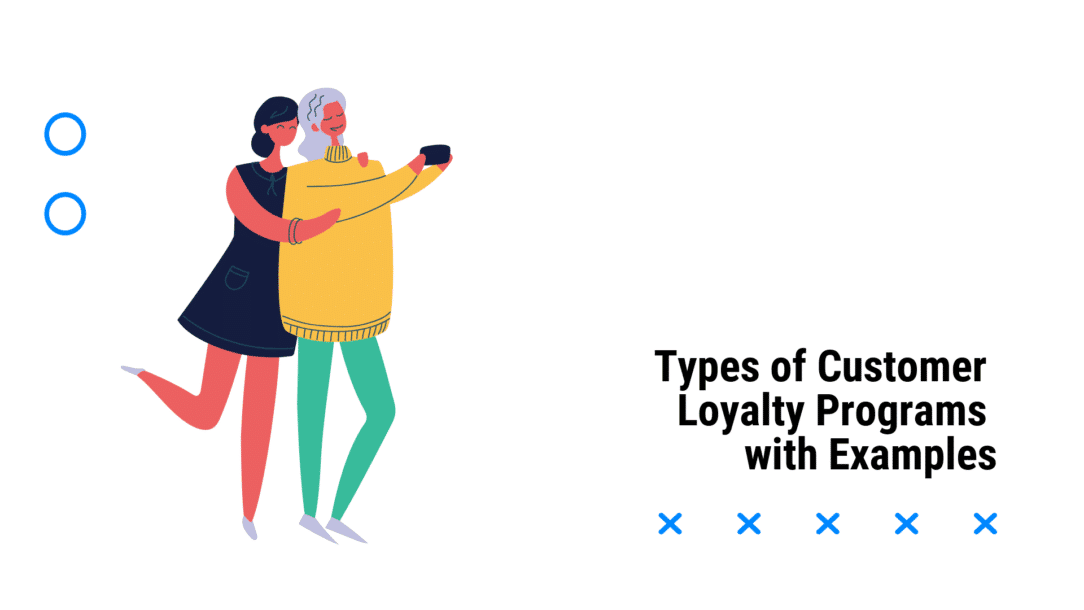For decades, customer loyalty programs have been essential for our commercial landscape. If you are a business, a retail marketer, or simply an enthusiast, you are most likely familiar with the concept of these programs. The basic purpose of these programs is to engage customers by offering them benefits, extra points, or simply discounts. If you want to read about what loyalty programs are, how they work, and how to make the most of them, check out here.
Now let’s focus on the types of loyalty programs currently available. What are the different types of customer loyalty programs? The answer to this question is not “one size fits all.” There are several different types, and each one has its pros and cons.
Let’s analyze the most common types of loyalty programs with examples. We will discuss the negative and positive sides of each of them as well as the main idea behind them. We will also take a look at examples for each type. After reading this article, you will understand how each type is different, which one you should choose for your business, and the essential points to consider when designing a customer loyalty program.
1) Point-Based System
The most simple and common type of rewards program is the Point-Based System. This system aims to let you collect points for each purchase and then use them to get rewards or benefits. The points can be stored in a simple account you automatically receive when signing up for the loyalty program. Alternatively, you can check your points balance on a card or an app every time you purchase.
Points-based systems are suitable for brick-and-mortar stores because they allow you to offer benefits more relevant to their business. For example, if you are opening a department store, you can give points for every purchase a customer makes in your store and then let them exchange the points for discounts on clothes.
When implementing a point-based system, consider how many points you give for each purchase. If the number is too small, your customers won’t care about it. If it is too big, they might not come back because the value of their points isn’t worth them spending money in your store.
For instance, Blume has the same strategy:
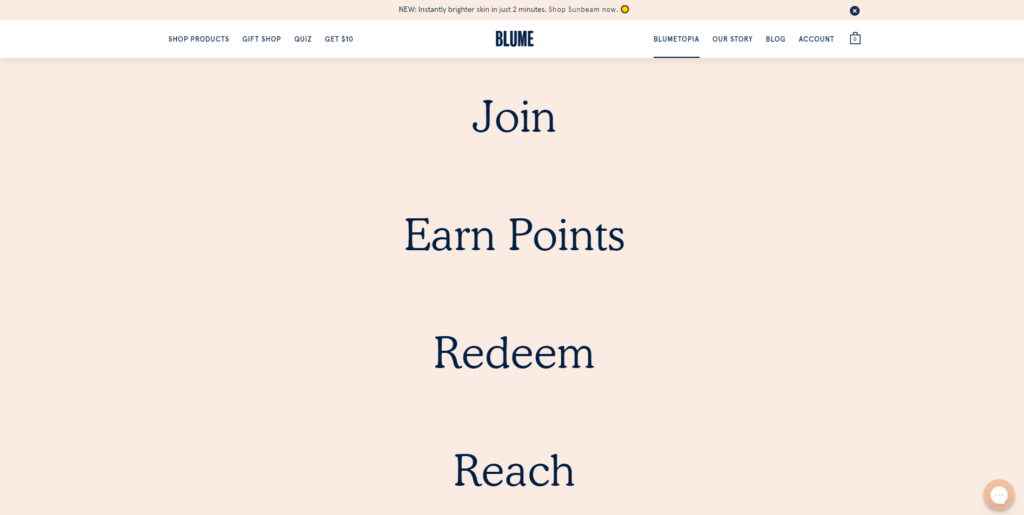
Blume Points
Blume calls these points BBs (Blume Bucks). When you have 100 BBs, you get one dollar. You also get points (BBs) when you share this with your friend, sign up to their email, when your friend makes a purchase, or when you leave reviews for products you bought at Blume.
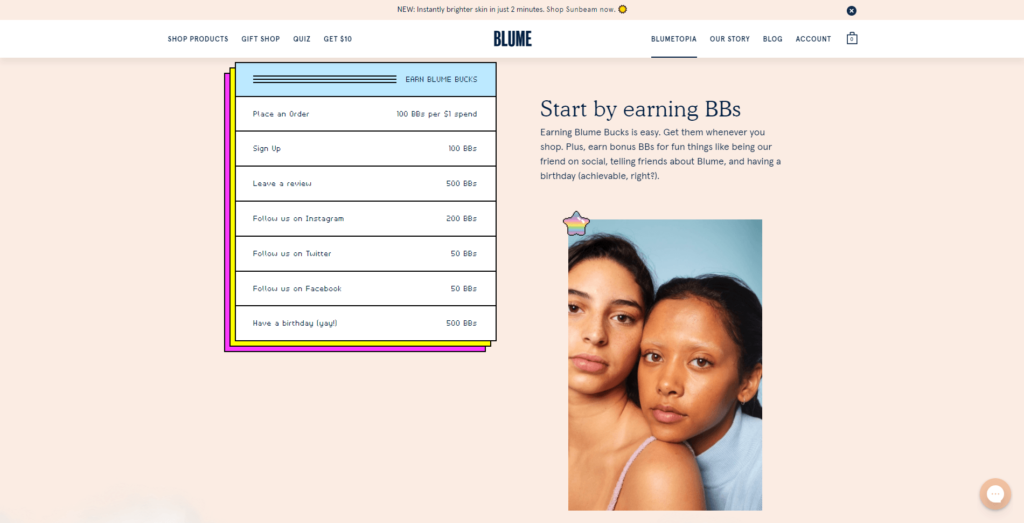
Blume – Earn BBs
The most significant advantage of the point-based system is that customers can use their points whenever and however they want. This way, you don’t need to provide any extra benefits for your customers and let them choose the best option. The best thing is you can use your collected BBs on several products on their products.
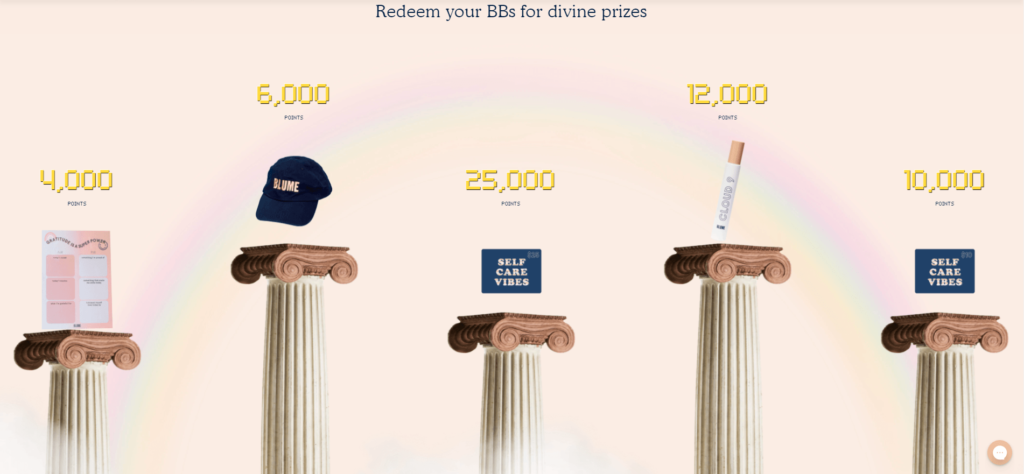
Blume – Redeem BBs
Pros
- Free membership allows you to attract more customers
- An ideal strategy to attract new customers and encourage them to make purchases
- Risk-free
Cons
- The points are not as valuable as cash
- Points don’t allow you to choose what discounts you offer your customers
- Nothing is creative—every business is doing it
- Lack of engagement
2) Tiered Programs
Tiered programs are similar to point-based systems. The main difference is that they usually have four or five tiers with different point accumulations. You need to reach a certain number of points before being able to move to the next tier. Each tier brings you better rewards and benefits.
Tiered programs are great for businesses that want to incentivize their customers to make more purchases, spend more money, refer their friends to the loyalty program, and leave reviews. The higher the value of your rewards and benefits, the more likely your customers will move up to a new tier. However, you need to make sure they don’t feel like making new purchases will be too hard because, otherwise, they might lose interest in your store.
For instance, Lancome, a beauty brand, has created multiple tiers for its loyalty program. Every tier brings different benefits, discounts, and additional points you can use to buy products or get free samples from Lancome.
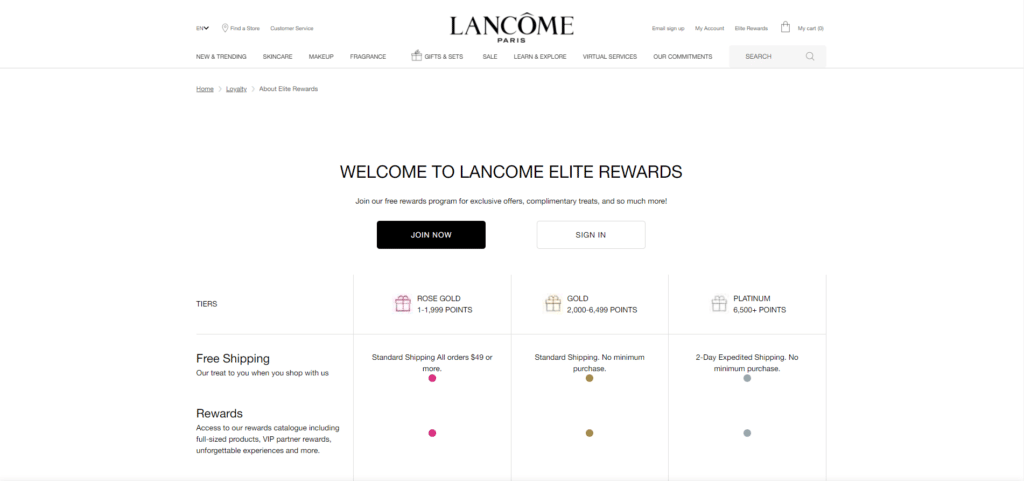
Lancome – Elite Rewards
Using this program, you can increase your average order value by offering a better experience to customers who spend a lot of money with you. You can also get more data about your customers, valuable for any business.
Lancome has divided these tiers into rose gold, gold, and platinum categories. Each category has more benefits depending on the tier.
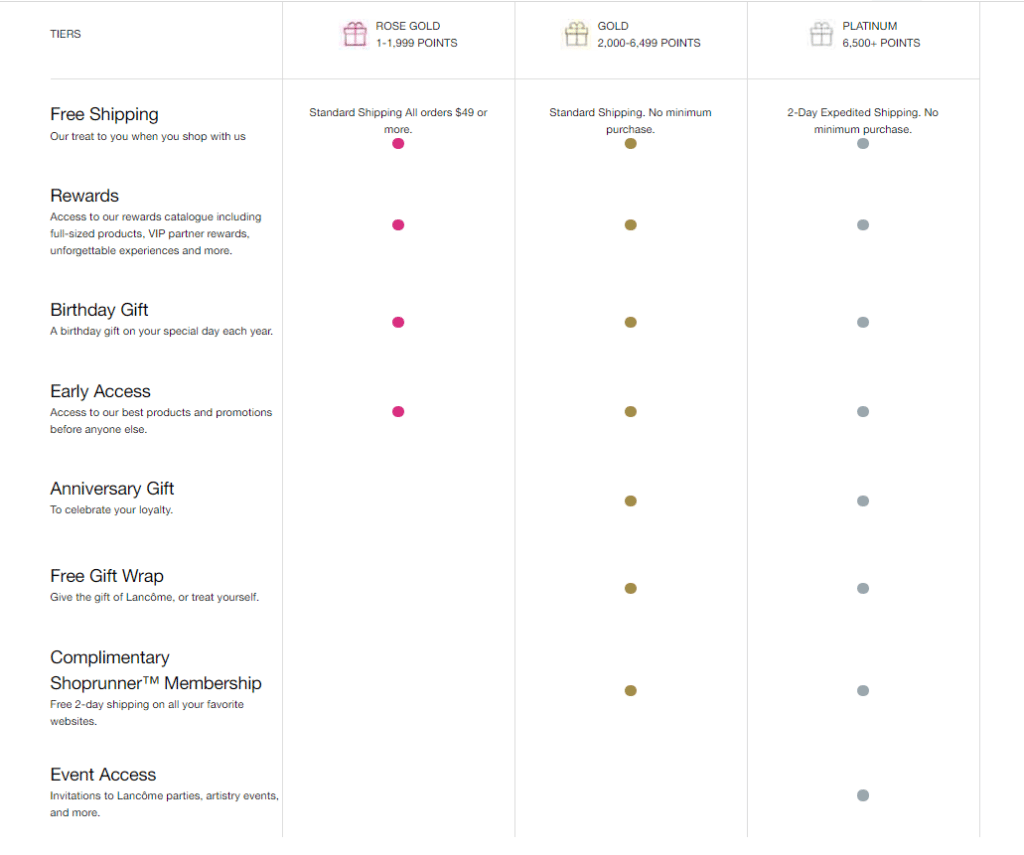
Lancome – Tiers
Pros
- More value for customers
- Only the best customers reach the best tier
- Multiple tiers allow you to incentivize your customers in different ways
- Customers feel like they’re moving up in the world when they get to the next tier
Cons
- Not beneficial for customers who don’t reach the main tiers
- If customers are degraded back to the lower level, it affects their next purchase
- Too many points are needed to reach the higher tiers
- Quite complex for customers to understand
3) Paid Membership Program
There are three kinds of paid programs: monthly, yearly, and lifetime. Customers have to pay a certain amount every month or year to belong to the loyalty program. This kind of program is ideal for customers who want more benefits without having to reach any specific goals.
Another good thing about these programs is that you can get some customers to buy more products because they don’t want to miss out on the benefits. The main problem with this program is that customers can easily forget about it or cancel their membership if they don’t see enough value. In these kinds of programs, you need at least 5%–10% of your customers to purchase to make it worth your time.
If you want to implement this program, then you need to be prepared for a lot of monthly fees and, at the same time, make sure you offer good benefits. According to the latest insights, 62% spend more on a brand after taking the paid membership.
For example, Anthropologie has created its Anthro Loyalty Program that offers many perks to its customers. For instance, all-time free shipping, special birthday treat, members-only promotions, and more.

Lancome – Tiers
Pros
- The engagement level is sky-high as only loyal members will pay for the membership
- Direct Revenue for businesses
- No lurkers can waste time and your efforts
- Members don’t always see the value in the program
Cons
- Not everyone will take a paid membership
- Fewer members
4) Value Loyalty Program
This program gives you a chance to add your own value system and award points for specific actions. Users can donate points from their earnings to a charity of their choice or exchange them for other rewards. You can create your own rules to add value to your loyalty program and motivate customers to participate.
People who participate in this program are more likely to buy from your store again because of the personal satisfaction they get from helping a good cause. Companies can leverage this benefit to get more customers to visit their websites and make purchases.
However, customers don’t get direct benefits as their earned points are donated to charities. But the satisfaction from supporting a good cause is enough to make them return. Based on the insights, companies can use this program as an effective tool to improve customer retention by offering personal benefits. For instance, Alaska Airlines lets you donate your miles to different charity organizations, including:
- The United Negro College Fund
- Make-A-Wish Foundation
- Dream Foundation
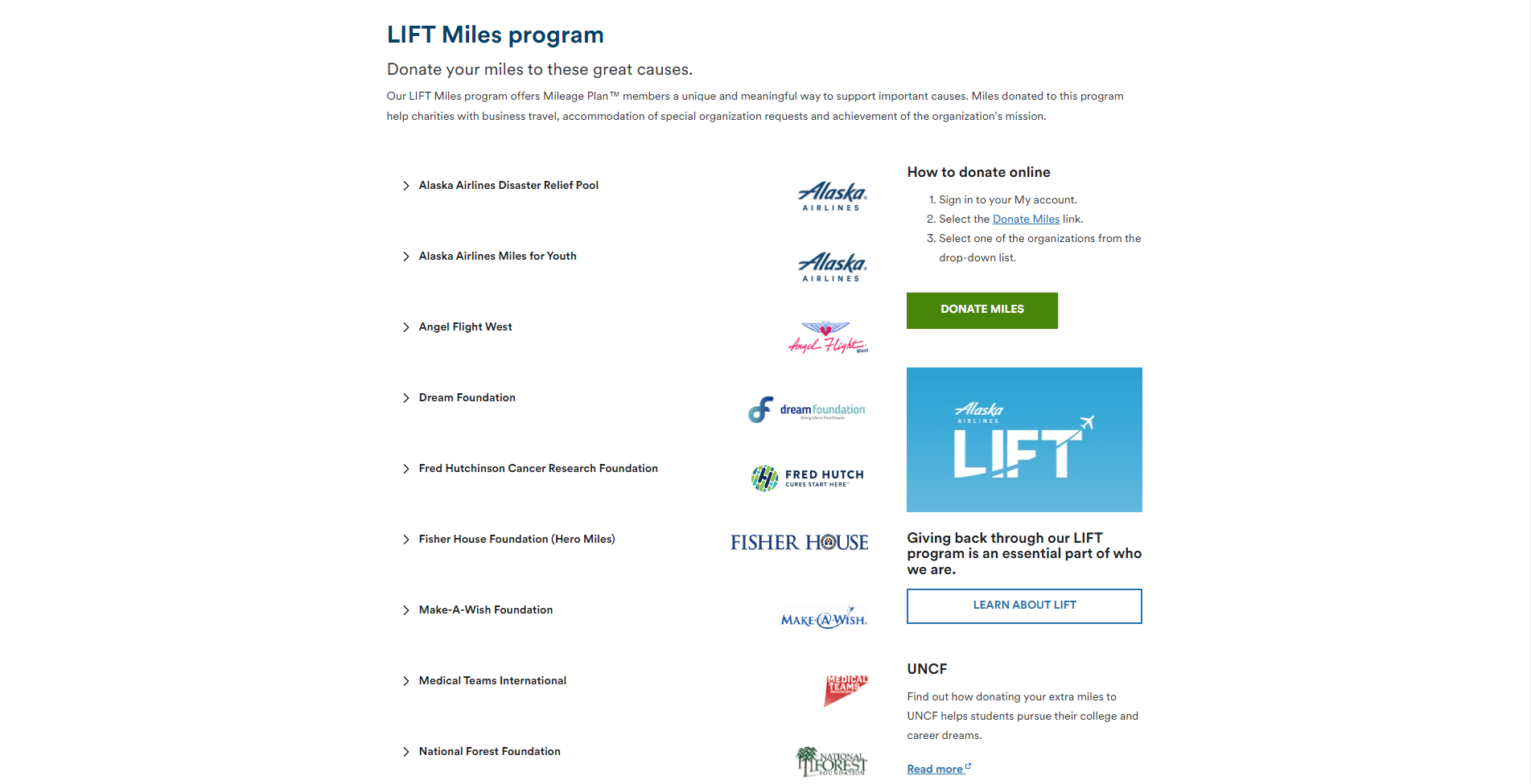
LIFT Miles program
Another example would be Delta Airlines. They also let you donate your miles, but you can choose between three different charities:
- Fisher House Foundation – Hero Miles
- American Red Cross
- CARE
- Habitat For Humanity
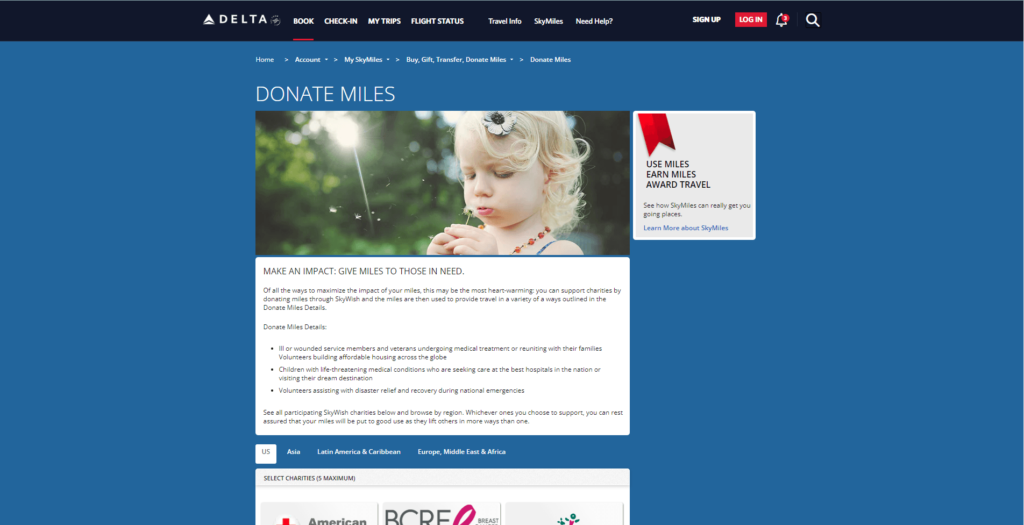
Delta – Donate Miles
The thing is: customers can choose to donate their points to the charity of their choice.
Pros
- Customers get satisfaction from giving back to the community
- Helps businesses improve customer retention rate
- Very specific to their target audience
Cons
- Requires implementation of complex technology
- Donations are not tax-deductible for businesses
- Customers are left without a cash value
5) Coalition Loyalty Programs
Many companies believe that the best way to motivate customers is by making their loyalty program more like a game. In coalition loyalty programs, brands collaborate and give their customers various discounts and offers. These campaigns usually last for a specific time and can be anything from a week to months, depending on the campaign.
One good thing about these programs is that they attract new customers to the store. People who might have never visited your website before will surely be interested in your products after seeing all the great offers you’re making. Depending on your business type, you can choose to collaborate with your shoulder niche business or other companies in the same market.
However, you need to be careful when choosing which brands to align yourself with. If the campaign’s offers are not good enough, then customers won’t be coming back.
Department stores like Macy’s and Lord & Taylor offer excellent campaigns once in a while, like when they partnered with H&M for a great deal. Another example would be Plenti – a rewards program that collects points from different brands. American Express started it. Users could utilize their points on gas stations, departmental stores, and restaurants. However, Plenti ended in 2018 when American Express planned to close the program as most users had not utilized their points.
Pros
- Increased marketing efforts
- Great opportunity to work with new businesses
- They receive support from partners
- A strong community of like-minded individuals
Cons
- Loyalty programs can be managed in different ways
- Offers must be valuable to keep customers coming back for more
- Working with different brands might be difficult at first
6) Punch Card Program
If you feel that a loyalty program is too complicated, a punch card might be perfect. Punch cards are easy to understand, easy to manage, and are great for small businesses. You can give 1 free item to customers after they have purchased 10 items.
Customers are encouraged to return because they know the reward is waiting for them. The best part about this program is that it’s cost-effective. Punch cards are inexpensive and don’t require any technology. You can design your card by hand or print it online. You can even download a template from the internet and customize it to meet your business needs.
As for the reward, you can choose what it will be. You could give your customers a free item after 10 visits, or you can make it more challenging by making them buy 20 items to get the same reward. You can also offer different rewards like 20% off your next visit or free shipping. It all depends on what your customers like.
For instance, Sephora’s punch card program called Beauty Insider gives customers a certain amount of points based on the number of items they purchased. Sephora offers them multiple perks based on the number of points they collected.
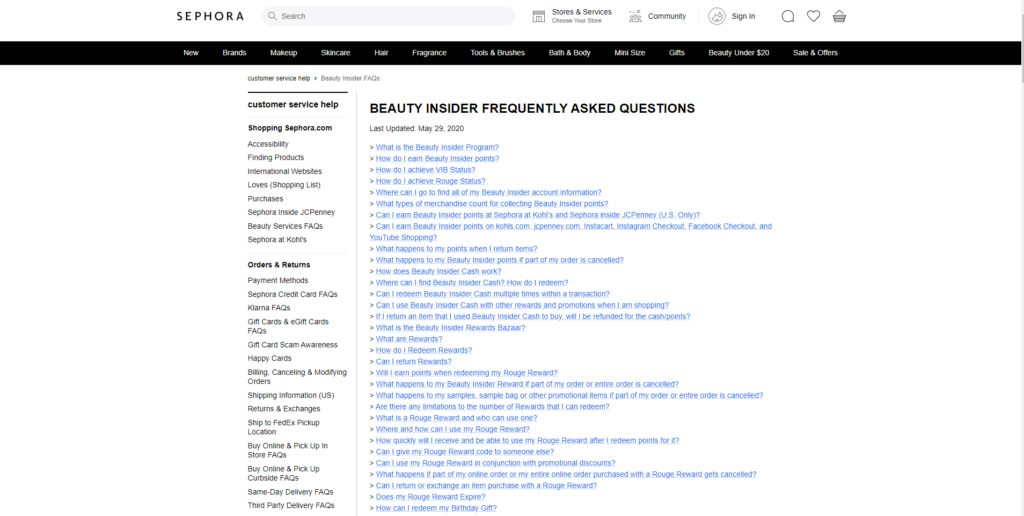
Sephora FAQs
You can join free beauty classes, invitations to special events, monthly gifts, birthday gifts, free shipping, discounts, etc. The punch card program is also easy to set up. All you need is a punch card template and the customer database.
Before implementing this program, think about what special perk you want to offer after the customer has reached a particular milestone. Aside from that, make sure your customers know how many times they need to visit your store to redeem their rewards.
With this program, customers can feel rewarded even if they can’t come to your store frequently.
Pros
- Punch card programs are easy to make and maintain
- No hardware or software required
- Can be modified according to your business needs
Cons
- Customers will tend to reach their limits faster
- Your customers need to spend more in order to get a reward
Conclusion
To conclude, loyalty programs are proven to help businesses get more customers and even improve their client base. It’s essential for companies to know the type of loyalty program they want to implement before implementing it. Customer loyalty programs should be able to engage customers and motivate them to come back again.
Make sure you choose a loyalty program that fits your business and meets your needs. To make sure you choose the right one, think about how much it costs, what type of program you want to create, and how it will affect your business. After all, the goal is to get more customers and keep them coming back for more.
Customers will feel appreciated through rewards and benefits, while business owners can increase their profit with customer loyalty programs. Don’t forget that not all loyalty programs are made equal. Choose the one that best covers your needs and satisfies customers’ desires.
Just remember, it’s not about the shape of the program but what it offers to customers.
Related Posts

